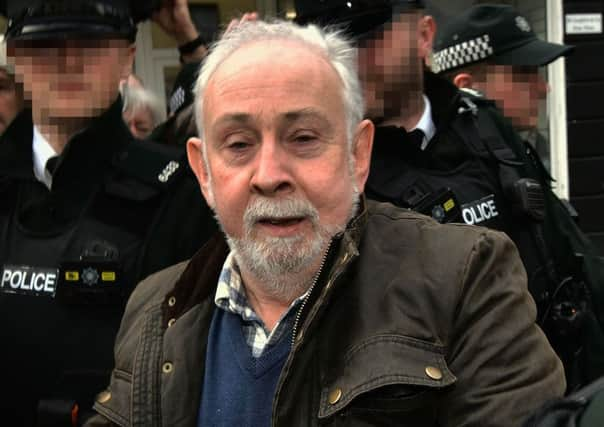John Downey: ‘Fingerprint link to car bombing’


John Downey is charged with murdering Ulster Defence Regiment members Alfred Johnston and James Eames in Enniskillen, Co Fermanagh.
He is facing prosecution after losing a battle against extradition from the Republic of Ireland.
Advertisement
Hide AdAdvertisement
Hide AdDowney’s bid to secure bail was adjourned for more legal documents to be provided to the judge hearing the application.
The accused, with an address in Creeslough, Co Donegal, is further charged with aiding and abetting an explosion likely to endanger life.
He was detained in the Republic in October 2018 under a European Arrest Warrant.
Since then he has fought extradition, but handed himself in to the authorities last week after exhausting all appeals.
Advertisement
Hide AdAdvertisement
Hide AdAppearing via a prison video-link, Downey spoke to confirm he could see and hear the proceedings.
A number of senior Sinn Fein representatives, including West Belfast MP Paul Maskey and MLAs Gerry Kelly and Caral Ni Chuilin, attended the hearing.
Lance Corporal Johnston and Private Eames died in an explosion on the Irvinestown Road in August 1972.
They were carrying out checks on a car when a command wire initiated device was detonated, killing them instantly.
Advertisement
Hide AdAdvertisement
Hide AdThe bomb went off as a truck carrying 13 off-duty soldiers approached, blowing it onto its side and injuring some of the troops inside.
That lorry is believed to have been the primary target for the attack, Mr Justice Horner was told.
Prosecution counsel claimed Downey’s fingerprint was found on insulating tape used to construct the device.
Although the original impression has since degraded, photographs of it were said to have been used in “multiple comparisons”.
Advertisement
Hide AdAdvertisement
Hide AdThey included analysis carried on prints taken from Downey last Friday, and also after his arrest at Gatwick Airport in 2013 for the 1982 bomb attack at London’s Hyde Park.
He had been due to stand trial for the murder of four Royal Household Cavalry men in the Hyde Park incident.
But the case against him collapsed after it emerged that he received a letter of assurance from the British Government that he was not wanted for any offences.
In court today, however, the Crown lawyer said: “It’s the intention to adduce the fingerprints taken at Gatwick as evidence in this prosecution.”
Advertisement
Hide AdAdvertisement
Hide AdHe added: “Forensic Service Northern Ireland have confirmed the fingerprint taken on Friday does match that on the insulating tape on the 1972 bomb.”
Bail was opposed due to the alleged risk of flight.
It was contended that the Enniskillen attack was outside the early-release period covered by the Good Friday Agreement – providing a strong incentive to abscond.
Defence barrister Michael Duffy countered that the case against Downey centres on fingerprint evidence which will be contested as a potential abuse of process.
He claimed delays in bringing the prosecution could be prejudicial, and also questioned the intention to rely on witnesses who are now dead.
Advertisement
Hide AdAdvertisement
Hide Ad“Without that print one can see that there essentially isn’t any case against this accused,” Mr Duffy said.
Citing his client’s age and health issues, counsel stressed that he fully complied with previous bail conditions and would not attempt to flee.
“Its clear that there isn’t anywhere he would go outside of Britain or Ireland,” he added.
Adjourning the application, Mr Justice Horner told both legal teams: “I want you to go away and make sure I have all the relevant documents and cases that I have to see.”